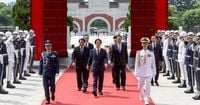On September 16, 2025, Taiwan’s All-Out Defense Mobilization Agency, operating under the Ministry of National Defense (MND), unveiled a newly updated civil defense handbook. This third edition, released in response to growing regional tensions and evolving security threats, aims to equip citizens with practical guidance for surviving not only natural disasters but also the increasingly complex risks posed by potential military aggression—chiefly from neighboring China.
Compared to the previous edition published in 2023, this latest version of the handbook places a much sharper focus on wartime scenarios. The handbook, according to the Central News Agency (CNA), lays out in detail the various types of military threats Taiwan might face from what it calls an "enemy state." These threats range from the sabotage of critical infrastructure such as underwater communications cables, to the staging of live-fire military drills in proximity to the island, and even the unilateral establishment of no-flight zones. The handbook also warns of the possibility of arbitrary boarding and inspection of Taiwanese civilian ships, suspension of traffic and commercial activity across the Taiwan Strait, drone incursions into Taiwan’s airspace, and ultimately, the risk of an outright armed invasion.
The release of this edition comes in the wake of several high-profile military exercises by China in the region. Notably, after then-U.S. House Speaker Nancy Pelosi’s visit to Taiwan in August 2022, China has ramped up its military posturing, staging a series of large-scale exercises around the island. The most recent of these, codenamed "Strait Thunder-2025A," took place on April 2, 2025, and was cited specifically in the handbook as an example of the types of maneuvers Taiwanese citizens should be aware of.
Beyond outlining the threats, the handbook is packed with practical advice for civilians. It instructs residents, should their area come under attack, to seek shelter in the nearest basement if possible. If caught indoors, people are urged to stay behind two walls and avoid exterior walls. For those outdoors during an attack, the handbook advises lying prone with faces turned away from explosions and shielding the head. The guide is explicit about the dangers of encountering apparent enemy forces, warning civilians to either quickly vacate the area or take immediate shelter.
Another key update in this edition is a caution against wartime disinformation—specifically, messages that claim the government has surrendered or that the military has been defeated. The handbook flatly labels such information as "false," a move clearly intended to counteract psychological warfare and misinformation campaigns that might be deployed in a crisis. According to the CNA, this reflects a heightened awareness within the government of the risks posed by both cyberattacks and information warfare, especially given the possibility that internet connectivity could be disrupted in a conflict. In such cases, the handbook recommends that citizens turn to reliable sources like the radio or government emergency hotlines to obtain accurate information.
The handbook also devotes space to the psychological and social dimensions of preparing for war. In a section aimed at families, the guide encourages adults to have open, honest discussions with children about the threat of war, involving them in practical preparations such as assembling go-bags and teaching them how to recognize and resist disinformation. The goal, as stated in the handbook, is to help ease anxiety and foster resilience among the youngest members of society. The guide further provides information on how individuals can volunteer, become certified disaster prevention specialists, or even enlist in the armed forces if they wish to contribute more directly to Taiwan’s defense.
At a press conference announcing the handbook’s release, Shen Wei-chih, head of the Materials Mobilization Division at the All-Out Defense Mobilization Agency, emphasized that the updated guide was compiled under the direction of the Presidential Office’s Whole-of-Society Defense Resilience Committee. The intent, Shen explained, is to "improve people’s understanding of dangers and self-protection skills." Shen also noted that physical copies of the handbook will be distributed in limited numbers at selected PX Mart stores across Taiwan, while downloadable versions are available in both Chinese and English through the official MND website.
Coverage by other outlets, including NHK, highlighted the handbook’s dual-purpose design. While its primary focus is on military emergencies, it also addresses natural disasters such as earthquakes—an ever-present threat in Taiwan. The handbook urges people to seek shelter underground or indoors whenever air-raid sirens sound, and to leave areas where military activity is suspected, given the difficulty civilians may have in distinguishing between friendly and hostile forces. It also stresses the importance of preparedness, with a ministry official telling NHK that the handbook "can spread the idea that the more prepared people are, the safer they will be." The same official added that the guide aims to help people protect themselves and others, while boosting their sense of commitment to Taiwan’s defense.
Importantly, the handbook anticipates that cyberattacks could disrupt internet connectivity during a crisis, and so it instructs citizens to rely on radio broadcasts or call government emergency hotlines for verified updates. This reflects an understanding of the modern battlefield, where information and communication infrastructure are as much targets as physical assets. The explicit warning against misinformation—especially rumors of government surrender or military defeat—underscores the government’s desire to maintain public morale and social cohesion in the face of psychological operations.
Beyond the nuts and bolts of civil defense, the handbook’s broader message is one of collective responsibility. By encouraging volunteering, disaster prevention training, and even military enlistment, the guide seeks to foster a "whole-of-society" approach to national security. This is a marked shift from earlier editions, which focused more narrowly on individual preparedness and survival tips. The new edition, in contrast, positions every citizen as a potential participant in the nation’s defense, whether through direct action or by supporting community resilience.
Distribution of the handbook is both practical and symbolic. While only a limited number of physical copies will be available at select PX Mart stores, the digital versions ensure that every citizen with internet access can obtain the information. The inclusion of both Chinese and English versions broadens the handbook’s reach, acknowledging Taiwan’s diverse population and the international interest in its security preparations.
For ordinary Taiwanese, the handbook is a stark reminder of the challenges the island faces, yet it also serves as a tool for empowerment. By equipping citizens with knowledge and practical guidance, the government hopes to bolster not just physical safety, but also psychological resilience and a sense of shared purpose. As the region continues to navigate uncertain waters, the updated civil defense handbook stands as both a warning and a call to action—underscoring the belief that, in times of crisis, preparedness can make all the difference.




